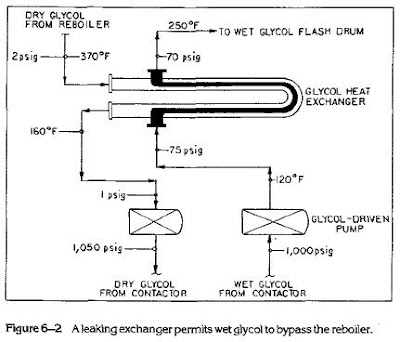Since lower temperature of rich glycol has higher viscosity, rich glycol solution tends to form emulsion.
Many ways can be taken to observe whether hydrocarbon carry over take place in glycol flash tank or not.
- Take sample from glycol flash tank, observe while taking sample. If glycol solution comes out from the tank and forms foam or emulsion, we can say "WE HAVE PROBLEMS HERE". Since vapour hydrocarbon is trapped (carry over) in to glycol solution.
- If glycol particulate or glycol charcoal filter is installed, observe it's pressure drop. Pressure differential will tell many. If pressure drop is fluctuating, it seems "WE HAVE PROBLEM HERE". Trapped vapour in pressure differential tube line can causes wrong reading of instrumentation.
- Another ways to make sure is open vent on top of glycol particulate/charcoal filter (if vent valve available). If large amount of vapour comes out while venting is opened, it seems the problems is confirmed. Hydrocarbon carry over in rich glycol solution will caused vapour trapped in glycol particulate or glycol charcoal filter. Since there is no on line vent on glycol filter, it will accumulate on top of filter.
If hydrocarbon carry over take place, several methods can be applied to avoid
- Operating at higher temperature, since hydrocarbon vapour will be flashed into top of glycol flash tank and reduce hydrocarbon carry over.
- Operate at lower pressure also result same effect, increase flash effect and reduce hydrocarbon carry over
- Check glycol flash tank design. Glycol flash tank may not be design for three phase separator.
Other problem may be found here
